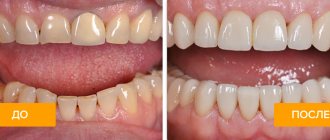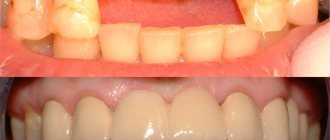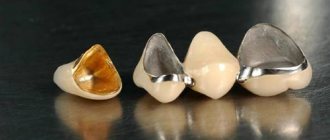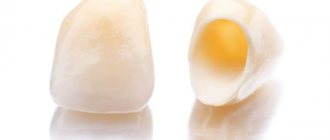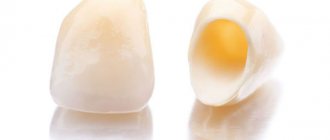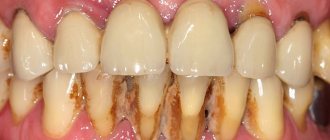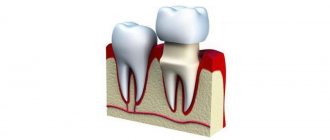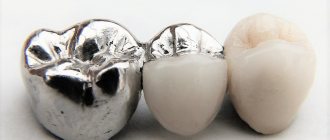Published 06/11/2020
Dental cement is used to fill or make dental prosthetics. There are several types of it, most often used in dental practice, however, the type of fixation is divided into permanent and temporary.
In what cases is it necessary to fix dental crowns?
Attaching dental crowns allows you to connect the structure to the dental tissue. How long the structure will last depends on this stage. High-quality installation of dentures provides relief from the negative impact of the external environment, one of the manifestations of which is caries. If the crown falls out, it can be glued back.
Causes of crown loss
The main cause of crown loss is most often sticky or hard food. But also some patients develop secondary dental caries . This can happen with improper treatment and installation of a denture, when the hard remaining tissues under the denture are poorly cleaned and provoke the development of bacteria and microbes.
Bad habits such as cracking nuts, chewing a pencil or pen can lead to crown loss.
Very rarely, some patients may experience an allergic reaction and incompatibility of materials with dental tissues.
How to remove crowns from teeth
Removing dental crowns is not a simple task, especially when it comes to completely preserving the prosthesis for the purpose of later installing it back in its original place.
We invite you to familiarize yourself with the names of brackets for straightening teeth.
If it is necessary to remove the crown due to its breakage, when there is no question of repair, then it is sawed with the help of dental instruments and removed in parts from the dental stump.
To preserve the prosthesis when removing the crown from a tooth, there are special tools:
- Crown removers (the most common tool model is the Kopp hook) are flat hooks with an automatic or manual mechanism, which allows, after fixing the crown to the tooth, to apply a certain force and remove the crown. Forceps are tools that allow you to securely fix the crown between the jaws and remove it from the base.
In modern dentistry, crowns are removed using ultrasonic units. When the tip passes around the area where the prosthesis connects with the stump, ultrasound causes crumbling and cracking in the cement, after which it is removed without much difficulty.
Another gentle method for removing crowns is the use of pneumatic tools, under the influence of which the cement is also destroyed and the structure moves away from the support.
Types of fixation
Fixation of dental crowns is carried out by a dentist using temporary or permanent cement (more details in the article: how is dental cement prepared?). Typically, dentists install a temporary restoration for a certain period of time in order to deal with specific dental pathologies before installing a permanent crown. For example, if a patient requires treatment for pulpitis or periodontitis, the dental canal must be accessible to the doctor. This can only be achieved with a temporary crown.
Temporary
Temporary installation of dentures allows the doctor to observe the reaction of the tooth before installing the denture permanently. In dental practice, plastic crowns are most often used for this, but acrylic and its derivatives are also in demand. The advantages of temporary fastening include:
- relatively cheap cost;
- maintaining the bite due to the fact that the tooth does not move to the sides;
- relief from pain in the case of nerve remnants;
- quick adaptation to the new tooth;
- maintaining correct diction;
- maintaining a pleasant aesthetic appearance.
Despite all the above advantages, temporary crowns have significant disadvantages:
- Composition and structure. The porous structure of the plastic allows pathogenic microorganisms to penetrate to the tooth stump, which sooner or later can provoke an inflammatory process.
- Material. Temporary cement quickly dissolves under the influence of saliva.
- Manufacturing. The methods for making temporary dentures are very primitive, as a result of which dentists insist on their fragility.
Dentists warn their patients about the high risk of temporary crowns falling out. To avoid this, doctors recommend eliminating sticky and hard foods, and also insist on chewing food on the side of the jaw that does not have a crown.
Constant
After a month of wearing a temporary crown, if the patient does not complain about any inconvenience, the doctor decides to replace it with a permanent one. Installing a permanent denture can be compared to the work of a craftsman - the dentist must prepare the tooth for the crown as carefully and efficiently as possible.
No matter how ideal the dentist’s work is, permanent crowns also tend to become loose and fall out. Possible reasons could be:
- the presence of secondary caries, which leads to tooth loosening;
- the development of diseases such as diabetes mellitus or any other somatic pathologies;
- incompatibility of tissues with materials for fixation;
- failure to comply with doctor's recommendations regarding prohibited foods;
- mechanical damage - impact, increased chewing.
Purpose of temporary and permanent cements in dentistry
Temporary cements are used at intermediate stages of prosthetics. With their help, it is possible to prepare the gums for the installation of a prosthesis. The material can last from several days to 1-1.5 years. The indications are:
- The need to check the condition of the dental pulp in case of mild pain. For this purpose, a temporary crown is fixed and the tooth is observed for several days. If necessary, treatment is prescribed, then the prosthesis is attached with permanent glue.
- When treating deep caries, when you need to repeatedly put medicine into the dental canals. To minimize pain for the patient and avoid the risk of damage to the working area between procedures, a crown is installed using temporary cement.
- When it is necessary to temporarily place a structure during orthodontic treatment.
The temporary cement is not too strong, which makes it easier to remove the crown. Therefore, you should avoid eating too hard food and chewing on the side with the temporary structure installed. You can make a temporary cement composition by changing the ratio of the proportions of the usual one to the liquid.
Permanent is used at the final stage of prosthetics, it happens:
- Zinc phosphate - has a long working time, allows you to obtain a thin, uniform layer (thickness up to 10 microns).
- Synthetic, adhesive - mainly used when installing ceramic veneers and simple bridges.
- Glass ionomer - releases fluoride and has adhesion to the crown material.
Materials for fixation and duration of fastening
The durability of an artificial crown undoubtedly depends on the quality of its fixation. An important criterion is the composition of the adhesive material. Cement or glue is usually used for installation.
Cement provides high strength of crown fixation for many years, while the effect of glue is limited to 12-24 hours. Accordingly, adhesive for dental crowns is often used at home, for example, in the case when the crown has fallen off, and the doctor does not have the opportunity to fix it in the near future.
Cement
Cement requires a professional approach, so it is used mainly only by dentists. At home, cement fixation of the prosthesis is extremely rare. Dentists distinguish between two main types:
- permanent, with a service life of more than 10 years;
- temporary, for short-term dental procedures.
There is another classification for dental cement for crowns. Depending on the composition, it comes in five types:
- Zinc phosphate. This is the easiest cement to use. Its preparation is carried out immediately before dental manipulation.
- Polycarboxylate. This type of cement is ideal for installing single crowns.
- Glass ionomer. Glass ionomer cement has high adhesiveness but low strength.
- Composite Unlike the previous type, composite cement is not so much adhesive as durable, but is contraindicated in patients with highly sensitive teeth.
- A polymer type of glass ionomer. Polymer-modified glass ionomer cement is the latest composition that has proven itself in dentistry. Despite the high level of strength and adhesiveness, they do not cause allergies or irritation.
Glue
Glue is widely used in dental practice, for example, for fixing dentures or fastening a broken bridge (we recommend reading: glue for dentures: how to glue a plastic bridge?). Its main disadvantage is its short-term effect. A crown glued to dental tissue with its help will stay in place for no more than a day.
The most popular glue options that can be found on pharmacy shelves are Rox, Forest Balsam, Lakalut, Fittident, Corega, Protefix. All of them are hypoallergenic and, accordingly, do not cause irritation or inflammation. The longest-lasting effect is provided by Lakalut and Corega, the effect of other drugs is limited to 12 hours.
Types of Dental Adhesive
A variety of adhesives are used in dentistry, for example, for removable dental bridges. The effect of such cement is short, about a day. Throughout this period, the mass does not harden, but remains elastic. You can buy such a substance at a pharmacy, and it is inexpensive, depending on the manufacturer. Such drugs are very often used to fasten a broken bridge. The advantage of adhesive masses of this type is that they freshen breath and have an antibacterial effect.
Only a doctor should prescribe a means for installing and fastening dentures. The composition and type of cement affects the duration of prosthesis fixation and occlusion. For example, the effect of glue intended for fixing inserted dentures is no more than a day, but the cement composition for crowns performs its functions for several weeks.
Good and high-quality material will completely fill all the voids, which will prevent food from getting under the crown, and therefore prevent the development of the inflammatory process.
You can buy dental glue in a variety of consistencies - liquid, thick or semi-liquid .
It is necessary to take into account the fact that it is necessary to use more thick and viscous cement than liquid or semi-liquid cement.
Attachment to implants
Such prosthetics do not require treatment of adjacent teeth. The structure itself can be installed in two ways:
- Screw fixation, when the crown is connected to the abutment adapter outside the oral cavity. After which the entire structure is screwed to the implant using a screw that passes through the hole in the prosthesis. After which the canal is closed with a special filling material. This method is more suitable for single crowns. Cement fixation, when the abutment is first fixed to the implanted root, after which the crown is fixed to it using cement. This method is preferable when prosthetics are performed on several teeth at the same time.
We suggest that you familiarize yourself with Dental treatment under anesthesia for children. General anesthesia.
Possibilities of dental cement
Glue for crowns makes it possible to tightly attach the crown to the root socket and prevent it from falling out of the gums. You can buy such material in specialized stores or at a pharmacy. Each dentist prefers to use a mass familiar to him, from a certain manufacturer. It must be said that if you buy inexpensive material, you can’t hope for a positive result.
Crown adhesive allows you to:
- firmly attach the crown to the tooth socket and thereby hold it during chewing movements;
- prevent the process of tooth decay from the inside;
- create a durable protective coating that will prevent bacteria from entering the tooth.
Fastening the crown to implants
This type of prosthetics does not require treatment of adjacent teeth. The structure itself can be installed in several ways:
- Cement fastening, in this case, the abutment is first attached to the implanted root, then the prosthesis is attached to it using cement. This method is better suited if several crowns are being prosthetized at the same time. Screw fastening, in this case the prosthesis is fixed with an abutment adapter outside the oral cavity. The entire structure is then screwed to the implant using a screw passing through the hole in the crown. The canal is then closed with filling material. This option is best suited for single dentures.
Types of dental cements for fixation of fixed dentures and crowns - classification
Today, the dental clinic market offers a lot of different compositions that are used to permanently secure permanent crowns and dentures in the patient’s oral cavity.
There are four main types of cement identified through experiments conducted by scientists and specialists over the past ten years. Their classification depends on the type of binding component present in the matrix and the specific indications for use.
Zinc phosphate dental cement for fixation of crowns and dentures
It is the oldest of the dental cement compositions that dentists now practice.
Mix immediately, right before use. It contains 65-70% powder, represented by magnesium or zinc oxides, and the liquid part is an aqueous solution of phosphoric acid.
Application
- Installation of single crowns and bridges on 3-4 teeth in patients without hypersensitivity.
- Fixation of pin structures on a well-preserved root protruding above the gum.
- Prosthetic bridges for more than 4 teeth.
Polycarboxylate cement for crowns
The powder combines zinc oxide and tin fluoride. The liquid part contains water and polyacrylic acid.
Characteristics of polocarboxylates:
- lowest adhesiveness and strength;
- excellent biocompatibility, the likelihood of allergies or irritation is almost zero;
- a thin layer of composition is required;
- serves as an additional prevention of caries.
Polycarboxylate cement for fixing crowns is ideal for fixing single crowns with increased tooth sensitivity. For all other clinical situations, there are better options.
Glass ionomer cement for fixation of crowns and fixed dentures
The liquid part of glass ionomer cement is represented by polyacrylic acid, and the powder part is not similar to those described in this material.
Aluminosilicate glass contains a high fluorine content.
Arde Kwik Tsem
The German drug Arde Quick Cem is a dual-curing microhybrid cement intended for fixation of dental structures in the form of veneers (both light-conducting and non-light-conducting), intracanal pins, bridges, crowns, etc.
Mixing cement can be done either automatically (in cannulas and syringes) or manually. The main advantages of Arde Quick Cem:
- increased fluidity (with the help of intraoral attachments, good filling of small posterior and anterior carious cavities that are difficult to access is ensured);
- high radiopacity;
- possibility of automatic mixing without the formation of air bubbles;
- relatively low price.
Arde Fix
Chemically cured German (Ardenia) glass ionomer cement is designed primarily for fixation of various dental structures - bridges, crowns, intracanal pins, onlays, orthodontic rings.
Arde Fix provides:
- high adhesion to dental tissues and orthodontic structures;
- guaranteed (chemical) polymerization, which ensures reliable fixation of internal structures, in particular intra-channel pins;
- non-oxidation and practical insolubility in oral fluids.
Fuji Plus
Fuji plus is a Japanese glass ionomer cement reinforced with a composite, and according to its main purpose it is classified as a fixing material.
With its help, various metal-composite, metal and metal-ceramic orthodontic structures are attached - inlays, dentures, bridges, crowns, intracanal pins.
The combination of a glass ionomer with a composite provides Fiji Plus a wide range of indications.
The material has:
- mechanical characteristics close to composite cements;
- high chemical adhesion to dental tissues, good adhesion to polymers, metals, ceramics;
- precise and easy fitting due to the thin film thickness;
- radiopacity, which makes diagnosis accurate;
- constant fluoride release.
Ketak Tsem
Ketac Cem is a hand-mixed GRC intended for the cementation of bridges, crowns made of various materials, and onlays.
Ketac Cem:
- has high chemical adhesion to orthodontic structures and tooth tissues;
- non-toxic, biocompatible with dental tissues;
- releases fluoride for a long time;
- does not require an absolutely dry surface;
- close in thermal expansion to dental tissues;
- provides high-quality edge fit and high wear resistance;
- has 5 color shades.
The only disadvantage of cement is its relatively high price. But given the 25-year documented history of successful international application, this disadvantage cannot be considered so significant.
Tsemion F
Cemion F Russian is a two-component material designed for fixation of various endodontic structures - crowns, inlays, intracanal pins, bridge prostheses.
The delivery set includes powder, which is a material based on polyacrylic acid and fluorosilicate glass, conditioner and solvent.
The advantages of Tsemion F include:
- abrasion resistance;
- high strength;
- good adhesion to tooth tissues and materials of endodontic structures;
- radiopacity;
- anti-carious properties due to the long-term release of fluoride;
- low cost.
Composite cement for crowns
The only type of all types is represented by two separate pastes. The first is basic, the second contains a catalyst.
Properties of composites:
- have record strength;
- decent level of adhesiveness;
- unfortunately, they often cause allergies;
- do not dissolve with saliva and other liquids;
- have excellent aesthetics.
The scope of application of composite cement for fixing crowns is quite wide:
- ideal for fixing any ceramic products - crowns, veneers, lumineers;
- are the optimal choice when installing any pin structures;
- are also well suited for any type of prosthetics, provided that the patient does not suffer from increased tooth sensitivity.
Composites are not recommended only for people with an increased tendency to secondary caries and high enamel sensitivity.
Application
- Permanent fixation of a wide variety of ceramic products (crowns, veneers, lumineers).
- The best choice when installing various pin structures.
- Prosthetics of any kind, if the patient does not have increased tooth sensitivity, etc.
Properties
- Record strength.
- High adhesiveness.
- Great aesthetics.
- Resistant to saliva and other liquids.
- Risk of developing allergies.
ATTENTION : Doctors do not recommend the use of composites when installing crowns, etc., for people who have an increased tendency to secondary caries, as well as high enamel sensitivity.
Polymer modified glass ionomer cement for fixation of crowns
It is considered the most advanced material for fixing crowns; it is supported by the combination of the advantages of composites and glass ionomers, as well as the content of a significant proportion of natural resins.
What is the function of glue?
After examination and during the process of grinding the tooth, the orthopedist decides which crown is best to install: removable or permanent, restorative or supporting. The patient is also asked to choose a construction material; it can be metal, metal-ceramics, plastic, or a combined composition.
To fix a permanent structure, a long-term and durable cementing agent is required. It tightly, hermetically holds the prosthesis in place.
Removable crowns require more troublesome care and the patient requires temporary cement to hold them on the tooth surface. You can purchase a similar adhesive composition in the pharmacy department; the cost of the product varies from 140 to 400 rubles.
There are several types of glue that not only hold crowns and dentures in place, but also have additional effects:
- retain moisture without absorbing it (a similar product is recommended for patients with increased salivation);
- do not allow pathogenic bacteria to pass through;
- make your breath fresh - if the glue contains flavoring additives.
Recommendations from experts on the selection and use of dental glue
In case of severe tooth decay, when treatment is simply impossible, crowns are used. This fixed prosthesis accurately imitates a lost tooth and performs all its functions .
Before installing a crown, the damaged tooth is ground down and then special dental cement is applied. This material allows you to firmly attach the crown and not move during the chewing process. This material, after hardening, becomes very durable.
A prosthesis fixed with such a mass can serve a person for more than 10 years without causing any inconvenience to the person - an unpleasant smell or taste.
Even if you buy the strongest adhesive, this does not guarantee that the cement will withstand even the most intense and severe loads . Very often, a crown can fall off at the most inopportune moment, and then you need to immediately contact your dentist. When this is not possible, you can fix the problem at home.
Temporary crown for front teeth
The absence of a side tooth may go unnoticed, but the absence of a front tooth brings significant discomfort, especially if it is the upper jaw. Preparing the main crown takes from 3 to 10 days, so temporary crowns are required. They are made of plastic or acrylic, which allows you to replace a damaged tooth with an artificial solution with minimal differences in the color shades of the teeth.
These materials are not intended for long-term wear. They are fragile and wear out quickly. Therefore, we strongly recommend that you do not wear temporary dentures for longer than the time prescribed by your doctor. For example, plastic can be colored by various drinks containing coloring pigments. But a permanent metal-ceramic crown no longer has such nuances.
Using cement for crowns at home
There is no need to despair if the prosthesis falls out, because you can temporarily glue it on yourself. Dental adhesive cement can be purchased at a pharmacy. It is worth saying that its composition is much different from professional cement used in dentistry. With these steps you can temporarily fix the crown until your next trip to the dentist.
Many people believe that by gluing a prosthesis at home, you can walk with it for a long time, but this is not so. The thing is that the dentist must first treat the tooth socket with special means and securely secure the crown. Only in this case can you count on the correctness and effectiveness of prosthetics.
The rules for using cement adhesive independently include the following points:
- Before the fallen crown is glued, it must be cleaned of old cement. To do this, use special dissolving liquids and a brush. Such cleansing preparations can be purchased in the form of tablets that dissolve in water.
- The washed prosthesis must be thoroughly rinsed under water and dried. If moisture remains on the crown, the bonding process will not be strong.
- Then you need to apply dental cement to the crown and put it in place. It is worth considering that the glue is applied in small dots.
- It is very important to place the crown accurately and evenly, and then clench your teeth tightly for a few minutes. This time will be enough for the prosthesis to firmly adhere to the tooth and fall into place.
- After such manipulations, you must refrain from drinking and eating for at least 30 minutes. If excess cement protrudes when pressing on the crown, it must be removed. It is worth saying that dental cement is non-toxic.
With proper dental care, this “home treatment” will last for a maximum of 2-3 weeks . To prevent the crown from falling off, you must not chew food on the problem side and brush your teeth very carefully.
Why did they do this before?
For example, while chewing food, the patient will feel discomfort; it is comfortable to chew on one side, but not on the other, although at first he did not notice this. The color of the crowns may be pleasant in the doctor’s office, but in other lighting, for example, on the street, it may not be as good as the rest of the teeth and will have to be corrected.
Often, for subjective reasons, it is necessary to redo the crown, the removal of which when installed with permanent cement presents a certain difficulty
Often, after installing prostheses, others may not even notice how much money was invested in their purchase. This can hurt and upset women. Remarks from others that the teeth are too small or, conversely, very large can force you to run to the doctor again to have everything redone. But these phrases can only be said out of envy, but some will take them calmly, while others will rush to correct everything.
Therefore, if the cement is temporary, then removing and redoing the crowns, adjusting the shape, changing the shade and installing them again will not be difficult. If the cement is already permanent, then the crowns are cut, thrown away, and their production and prosthetics begin again from the very beginning. Although this rationale for using initially temporary cement is understandable, this approach has long been outdated.
Consequences of using cement and glue for attaching prostheses
Independent use of cement or glue to fix dentures cannot be considered absolutely safe. Their use can provoke poisoning of the body due to an excess of zinc. Everyone also knows that zinc causes copper deficiency, which leads to neurological pathologies. The only reliable way to protect yourself from these side effects is to promptly contact a dentist who uses high-quality and professional adhesives for attaching dentures.
Sources:
- https://AzbukaZubov.com/protez/koronki/klej-dlya-zubnyh-koronok.html
- https://stoma.guru/protezirovanie-i-implantaciya/koronki/mozhno-li-kupit-v-apteke-zubnoy-cement-dlya-koronok.html
- https://www.operabelno.ru/vidy-stomatologicheskix-cementov-dlya-fiksacii-zubnyx-protezov-koronok/
- https://www.dentalpiter.ru/protezirovanie-zubov/cement-dlya-koronok-vidy-i-osobennosti-primeneniya
- https://www.vash-dentist.ru/protezirovanie/nesemnyie-p/stekloionomernogo-tsementa-dlya-fiksatsii-koronok.html
Indications for use –
A temporary crown on a plastic tooth is necessary, in principle, only in one case - it allows you to protect the tooth ground for a crown from aggressive factors in the oral cavity, as well as restore diction and aesthetics - while permanent metal-ceramic or ceramic crowns are being manufactured (on average, this period is 2- 3 weeks).
If we are talking about a large number of ground teeth at once, then temporary crowns made of plastic also help restore chewing efficiency - after all, you definitely won’t be able to chew with ground teeth. Some patients refuse to have temporary crowns made, citing significant additional costs.
What will the doctor do?
Which doctor is best to see if a dental bridge has fallen off? In general, dental prosthetics is the domain of an orthopedic dentist. If the prosthesis is on implants, then you will need to visit both an orthopedist and an implantologist, because The problem may be with the implant. Will the doctor be able to fix the old prosthesis? Here you will first need to undergo diagnostics, incl. tomography of the jaw, which will help determine the condition of the bone around the roots, the quality of root canal filling, and identify cracks in the roots.
If the support is in order and suitable for prosthetics, and the prosthesis itself has no flaws (i.e., the problem of falling out was only due to low-quality cement), then you can try to glue the old bridge in place. Of course, using new and high-quality cement.
If the doctor considers that the support needs treatment or removal, and also if the prosthesis is made incorrectly or is broken, then in addition to the main treatment, it will be necessary to make 1 new orthopedic bridge structure or, in principle, a different type of prosthesis.
Installation cost
| Name | Price, rub. |
| Initial examination-consultation | |
| Metal-ceramic crown “Japan” | |
| 5200 | |
| 5500 | |
| NHS | 3800 |
| KHS | 5000 |
| Metal-ceramic crown “Germany” | |
| NHS using shoulder mass and ind. color selection | 5700 |
| CHS using shoulder mass and ind. color selection | 6000 |
| NHS | 4800 |
| KHS | 5500 |
| Crown based on zirconium dioxide | 17000 |
| Solid crown | |
| NHS | 3000 |
| KHS | 3500 |
| Stamped crown | 2300 |
| Combined crown | 3000 |
| Plastic crown | 2000 |
Methods of fixing removable dentures
With the fixation of dentures that can be removed, the situation is more complicated. Particular difficulties can arise with the attachment of partial and complete acrylic or nylon dentures.
Fixation of full-type removable dentures (when teeth are missing) occurs due to the suction effect that occurs in the oral cavity.
Clasp-type dentures are attached using attachments (locks) or clasps (metal hooks).
In order to securely fasten such structures in the mouth, a whole range of measures are used: the partial denture is attached using metal or acrylic hooks, resting on the remaining teeth; the alveolar processes serve as an additional place of fixation. When you put on a removable denture, a suction effect occurs, which also contributes to good fixation.
If your oral cavity remained motionless, then the measures listed would be quite sufficient. However, when you eat food, when you chew, or sneeze, yawn, if you have active facial expressions, then as a result of this, the hooks are displaced, air gets under the prosthesis, which in the future can lead to its displacement or even falling out.
Cases in which it may be necessary to remove crowns:
Error of the attending physician at any stage. Due to the human factor and insufficient experience to perform such complex procedures, the dentist may not have done his job conscientiously. This can lead to complications and inflammatory processes described above. Mistakes when taking impressions and creating crowns.
The patient may not notice technical errors even at the stage of temporary fixation of crowns. However, sooner or later they will make themselves known. Planned or urgent replacement of crowns. Even the most durable crowns need to be replaced at the end of their life. Also, do not forget about circumstances beyond the control of doctors (damage to crowns, failure to follow doctors’ recommendations).
The procedure for removing crowns is quite unpleasant. In order to remove crowns, the doctor saws them with disks or a bur, risking damage to the oral mucosa. In this case, the use of anesthesia is recommended.
